Kazuo Ishiguro
Biographical
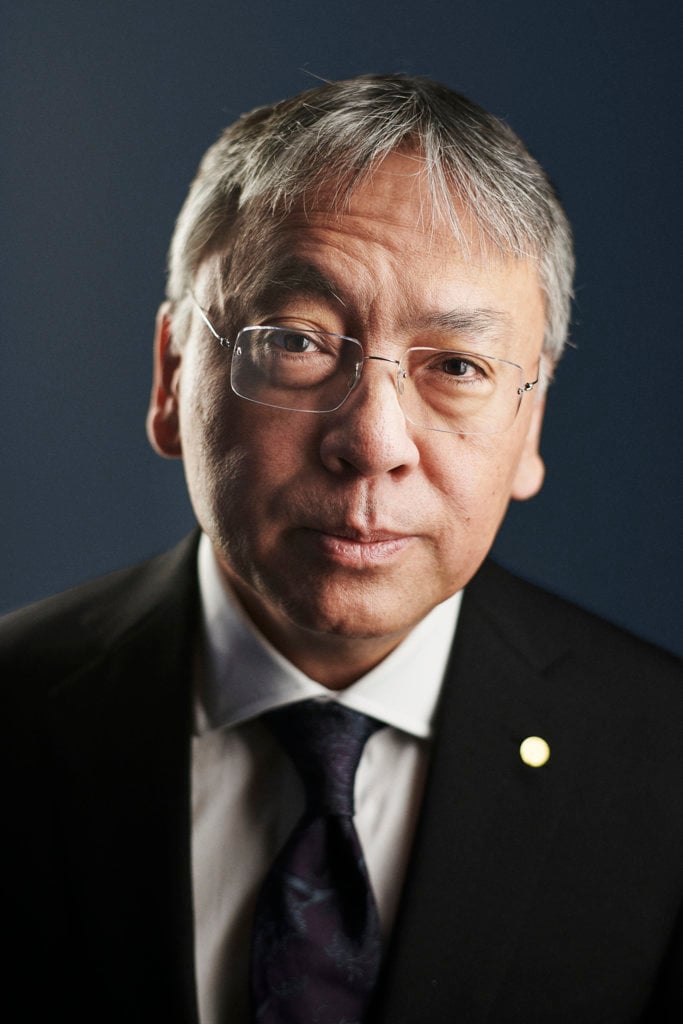
Kazuo ishiguro was born in Nagasaki, Japan on 8th November 1954. The house he lived in for the first five years of his life had been built in the traditional Japanese style, with tatami mats and sliding shoji screens. Early photographs show Ishiguro as a baby, sitting as formally as he was then able, in front of family samurai swords, banner and heirlooms. The house was three generational, with his paternal grandfather as head of family. His grandfather had spent many years away from Japan, in Shanghai, charged with establishing Toyota, then a textile machinery company, in China. Ishiguro’s father, Shizuo, had been born in Shanghai in 1920. His mother, Shizuko, like all members of her immediate family, was in Nagasaki when the atom bomb was dropped on the city in August 1945. Ishiguro attended kindergarten in Nagasaki and learned hiragana, the first and simplest of the three Japanese alphabets.
Ishiguro left Japan with his parents and elder sister in April 1960 to live in Britain, after Shizuo Ishiguro, a research oceanographer, was invited to work for the British government at the National Institute of Oceanography. The family settled in Guildford, Surrey, thirty miles south of London, expecting to stay in England for two years at most. The young Ishiguro attended the local school and became a choirboy at the neighbourhood church. From age 11, he attended Woking County Grammar School where he was educated until going to university. Although the Ishiguro family regularly considered returning to Japan, Shizuo Ishiguro’s research continued to be supported by the British government, and the family never returned. (The storm surge machine Shizuo Ishiguro invented is now a part of the permanent exhibition at the Science Museum in London.)
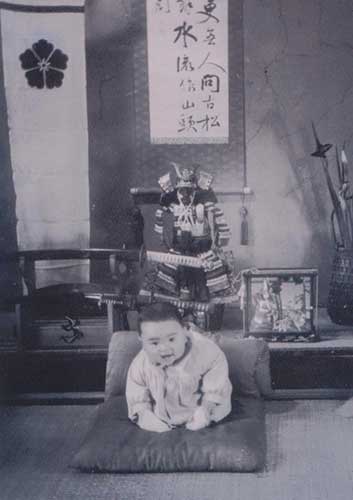
Figure 1. Images from Nagasaki, Japan: a) Baby samurai circa 1955.
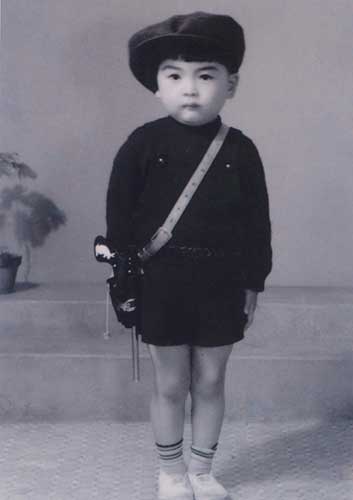
Images from Nagasaki, Japan: b) Policeman 1958.
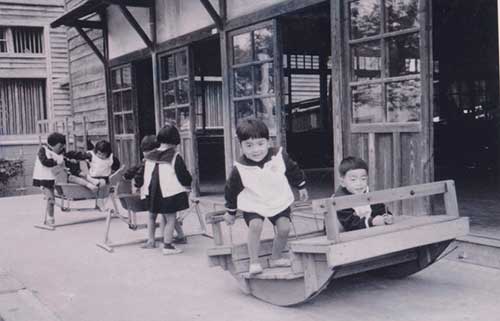
Images from Nagasaki, Japan: c) Kindergarten 1959.
During his teenage years Kazuo Ishiguro, like many of his peers, became interested in music, and from the age of fifteen began writing songs, inspired by his heroes Bob Dylan, Leonard Cohen and Joni Mitchell, as well as by the traditional folk songs of America, Scotland and Ireland. He became part of a circle of friends who wrote and performed their own songs at small local venues, and who argued about and critiqued one another’s work, often savagely. (He had received piano lessons from the age of five, and had taught himself guitar from the age of fourteen.)
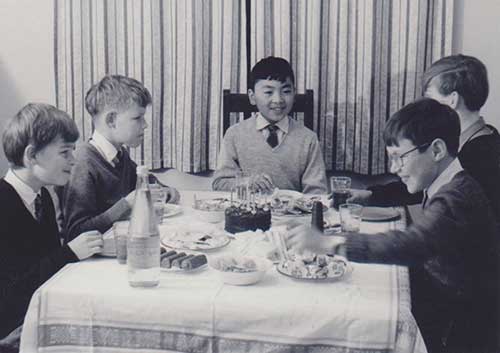
Figure 2. Birthday party. Guildford, 1964.
His first employment after leaving school in the summer of 1973 was on the Scottish moorland, working as a grouse-beater for the Queen Mother at Balmoral Castle (the British royal family’s summer retreat), assisting the royal guests to shoot game birds. In April 1974, after saving some money working in a storeroom packing baby food products, Ishiguro spent three months travelling with a backpack in the USA and Canada, usually hitch-hiking, but at one stage travelling by freight train from Washington state, across Idaho to Montana. On his return to England, he made his first attempts at fiction, writing two short stories inspired by his experiences in North America.
In the autumn of 1974 Ishiguro went to the University of Kent at Canterbury (UKC) to study for a Bachelor of Arts in English Literature and Philosophy. Almost immediately on arrival, he was introduced to the works of Proust and Kafka, two writers who were to have a strong influence on him thereafter. After the fresher year, Ishiguro was permitted an intermission from the degree course, and in April 1976 went to Renfrew, Scotland, for six months to work as a community worker in a ‘multiple-deprived’ area. Here, associating with local trade union officials and struggling families, he became sensitive to political issues. Also in 1976 he began work on what was to be his first (unpublished) novel.
He returned to his university studies in the autumn of 1976, graduating in 1978. By the time of graduation, he had become interested in Charlotte Brontë, Jane Austen, Dostoyevsky, Tolstoy, Chekhov and the Socratic dialogues of Plato. He had continued to write his own fiction, starting a second (unpublished) novel in 1977, and to write and perform songs at local folk clubs.
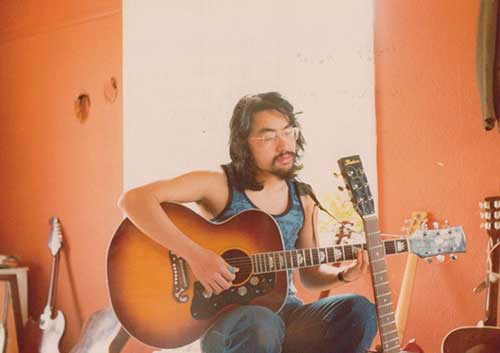
Figure 3. With guitar. Broadoak, Kent, 1977.
From January to summer of 1979 Ishiguro worked as a volunteer in the Notting Hill area of London for a charity organisation, West London Cyrenians, dedicated to campaigning about and tackling the homelessness problem. It was during this time that he met his future wife, Lorna MacDougall, also working for the organisation.
In the spring of 1979, while still working with the homeless, Ishiguro applied for a place on a pioneering Master of Arts course in Creative Writing at the University of East Anglia (UEA). At the time, no other university in the country offered such a degree. It was a small course (on average three or four students per year) and run by the renowned professor and novelist Malcolm Bradbury. Ishiguro was accepted on the course and was part of a class of six − the largest thus far in the ten year history of the course. The great British writer Angela Carter, then far from wellknown, became his personal tutor, and remained a close friend and mentor to him until her early death, aged 51, in 1992.
During his year at UEA, where he arrived in October 1979, Ishiguro began to publish short stories in small literary magazines. Three of his stories then were accepted by the London publishing house Faber and Faber (until not so long before run by T.S. Eliot) to be included in the forthcoming book Faber Introductions 7: Stories By New Writers (pub: 1981). This led to the start of an important relationship with Faber fiction editor Robert McCrum, who gave Ishiguro a contract and an advance for the novel he was then writing. The novel, A Pale View of Hills, was published in 1982 in the UK and in the USA. It was awarded the Winifred Holtby Memorial Prize by the Royal Society of Literature, and was subsequently published in several foreign languages. The novel allowed Ishiguro to be included as the youngest member of GRANTA magazine’s first ‘20 Best of Young British Novelists’ promotion in 1983, alongside writers such as Salman Rushdie, Martin Amis, Ian McEwan, Julian Barnes, Graham Swift, Pat Barker, William Boyd and Rose Tremain, many of whom were little-known at that point.
After completing his Creative Writing MA, Ishiguro returned to work with homeless people at West London Cyrenians, but became a full-time writer in autumn 1983, following the publication of A Pale View of Hills. Around this time he wrote two screenplays for television, the first of which − A Profile of Arthur J Mason − was broadcast on British national television in 1984 (director Michael Whyte) and won the Golden Plaque Best Short Film at the Chicago Film Festival. This teleplay featured an English butler as its central character and was thus something of a forerunner to The Remains of the Day. A second screenplay, The Gourmet (director Michael Whyte), was filmed and broadcast in 1985. Meanwhile, Ishiguro had begun work on his second novel, An Artist of the Floating World, which was published in 1986.
An Artist of the Floating World was shortlisted for the Booker Prize and won the Whitbread Book of the Year Award, making Ishiguro a highly visible young writer. He married Lorna MacDougall in 1986. (Their daughter, Naomi, was born in 1992.)
In 1989 Ishiguro published The Remains of the Day which won the Booker Prize that year. The book was widely acclaimed and became an international best-seller. A film adaptation, directed by James Ivory, starring Anthony Hopkins and Emma Thompson, was released in 1992 and was nominated for eight Oscars.
In 1994 Ishiguro served on the jury at the Cannes Film Festival (alongside, among others, Clint Eastwood and Catherine Deneuve) that awarded the Palme d’Or to the then little-known Quentin Tarantino for his Pulp Fiction.
In the years that followed, Ishiguro published further novels − The Unconsoled (1995), When We Were Orphans (2000), Never Let Me Go (2005), The Buried Giant (2015) − and a volume of stories, Nocturnes: Five Stories of Music and Nightfall (2009). These books were translated widely and earned Ishiguro many honours around the world, including the Order of the British Empire (1990) and the French decoration Chevalier de l’Ordre des Arts et des Lettres (1998).
A film co-written by Ishiguro, Guy Maddin and George Toles, The Saddest Music in The World, directed by Guy Maddin and starring Isabella Rossellini, was released in 2003. Another film, written by Ishiguro and directed by James Ivory, The White Countess, starring Ralph Fiennes and Natasha Richardson, was released in 2004. A film adaptation of Never Let Me Go, directed by Mark Romanek and starring Carey Mulligan, Andrew Garfield and Keira Knightley was released in 2010. A Japanese stage production of Never Let Me Go, directed by renowned theatre director Yukio Ninagawa opened in Tokyo in 2014, and in 2016 a 10-part series based on Never Let Me Go ran on Japanese prime time television.
Ishiguro has worked as a lyricist for the jazz singer Stacey Kent, writing songs in collaboration with the composer and saxophonist Jim Tomlinson. Their songs have appeared on the Stacey Kent albums Breakfast on The Morning Tram (2007), Dreamer In Concert (2011), The Changing Lights (2013) and I Know I Dream (2017).
In recent years, Ishiguro has received accolades with life-time achievement connotations: The Peggy V. Helmrich Award (2013), The Library Lion Medal from New York Public Library (2014), The Sunday Times Distinguished Author Award (2014), The Golden Plate from the American Academy of Achievement (2017). In 2018 he received a Knighthood from the United Kingdom, and the Order of the Rising Sun, Gold and Silver Star, from Japan. Also, in 2018, he was made an Honorary Citizen of Nagasaki City and Prefecture. In 2019 he received the Bodley Medal from the Bodleian Libraries of Oxford University.
He received the Nobel Prize in Literature in 2017.
Nobel Prizes and laureates
Six prizes were awarded for achievements that have conferred the greatest benefit to humankind. The 12 laureates' work and discoveries range from proteins' structures and machine learning to fighting for a world free of nuclear weapons.
See them all presented here.
